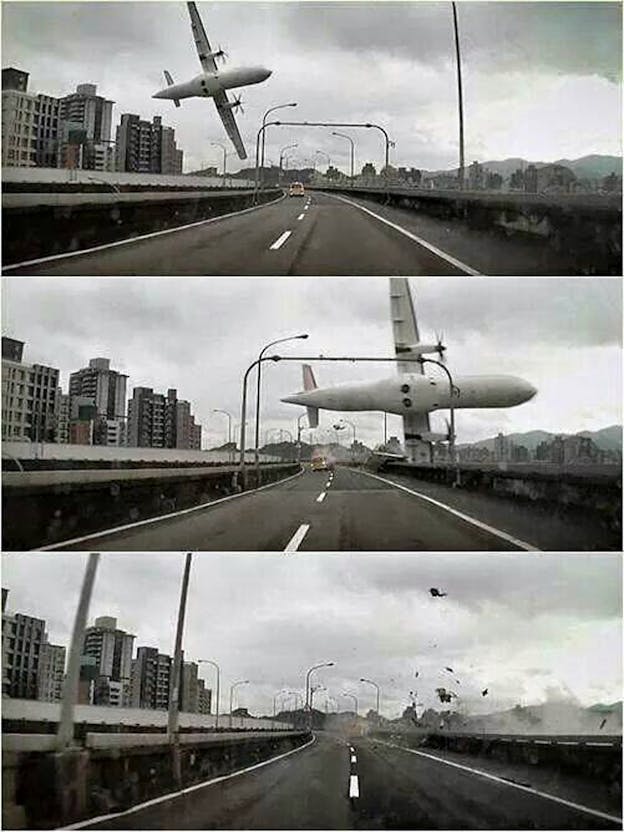This spectacular triptych, recorded just moments before TransAsia Flight 235 crashed, is part of a genre of photography in which actual events look like special effects from movies (in this case the sequence when Denzel Washington averts disaster by inverting the damaged plane in Flight). It would sit alongside the dashboard-camera footage—also broken up into stills—showing the sci-fi meteor strike in Russia in 2013. The comparison with the movies is even stronger in British English, where we refer not to a car’s windshield but its windscreen. People who witness such scenes invariably articulate their experience by saying it was “just like a movie”—often the kind of movie you don’t want to watch when you’re on a plane. The filmic syntax is especially telling here, because these images are not the only record of a mobile view of the crash. Just as they show a taxi in front, so another car filmed our car as it was filming an event in which it, in turn, plays a minor but active part.

In the wake of Malaysia Airlines Flight 370’s disappearance without a trace, it is a relief, of sorts, to come across an air disaster that was caught on film. In addition, 15 of 58 passengers and crew survived the TransAsia crash. The knowledge that there are survivors also alters our ethical position in regard to looking at these photos. While it did not represent the triumph of engineering and grace under pressure achieved when Capt. Chesley Sullenberger landed his stricken craft on the Hudson with zero loss of life, the fact that so many survived means that the outcome was, all things considered, extraordinary. Depending on whether you are of a glass half-full or half-empty disposition, the event captured here might even be a cause for qualified rejoicing since, at heart, even as we obey the pre-flight safety briefing, we assume that if our plane goes down we’ve had it, irrespective of whether the seat belts are buckled and the evacuation slides deploy.
Increasingly, images like these are derived from sequences of video footage either shot by quick-thinking amateurs who happen to be on the scene, or recorded passively and automatically by cameras that capture whatever passes in front of them, irrespective of whether it’s anything or nothing—i.e. everything. Given the rich tradition of images shot from moving cars (from art stars such as Robert Frank, Garry Winogrand, Lee Friedlander, and Dennis Hopper to anonymous Marines peering through the reinforced windows of Humvees in Iraq and Afghanistan), I am surprised that an exhibition has not been devoted to such photos. Ideally, the exhibition would be the artistic equivalent of a drive-in, so it would best be mounted in Tucson rather than Manhattan.
